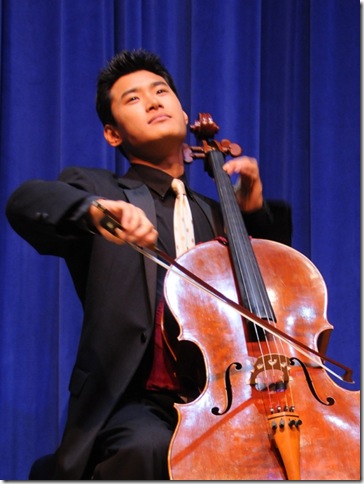The cellist Jonah Kim has spent several years concertizing and living in South Florida, including studies at Lynn University, all the while building a wider career from two other home bases in New York and Prague.
Tuesday night’s closing concert of the Stringendo School for Strings faculty series at Palm Beach Atlantic University’s Persson Hall showed why it is that he’s been successful.
Kim, a native of Seoul, South Korea, performed one of the great chestnuts of the cello repertoire, the Sonata for Arpeggione (in A minor, D. 821) of Franz Schubert, and played it with surpassing excellence: superb intonation, brilliant fingerwork, and a spirit of fun and discovery that he managed to evoke even though he’s surely played this piece many dozens of times.
With the able, expert accompaniment of Taiwanese pianist Yueh-Yin Liao, a doctoral student at the University of Miami, Kim simply took care of things, Schubert-wise, giving the piece everything it needed, from high-spirited, forceful rhythms to singing melody, and doing it with technical perfection.
But there was more to his performance than just spotlessness. He and Liao collaborated well on little touches such as the extra emphasis they gave to the final cadential figure each time it returned, and Kim also made a point of stressing the chromatic motif that leads back into the opening theme of the first movement, echoing it in the transition to the third movement.
His intense, cutting tone made his flawless arrivals in the A-string stratosphere stand out that much more, and gave the beautiful song of the second movement a pleading, heart-on-sleeve quality. Tying it all together was a sense of engagement that made this nearly 200-year-old music sound utterly fresh.
Kim was equally fine as the cellist in the showboat Passacaglia that the Norwegian composer Johan Halvorsen built for violin and cello (originally viola) out of a keyboard suite by Handel. The violinist was David Mastrangelo, an able member of the Naples Philharmonic who, like Kim (who stood up for the last variation), couldn’t resist some physical theatrics as the piece traveled on its increasingly flashy way.
While Kim’s intonation was spot-on throughout, Mastrangelo’s was not, and in a piece like this, which is about dialogue and stuntsmanship, that made for some less-than-ideal harmonic clashes. Both musicians attacked their parts with verve and fire, and it made for an explosive ending to the concert that the large audience acclaimed.
The program also featured a rarity in the early Piano Quintet (in C minor) of the Russian composer Alexander Borodin. Like much of Borodin’s work, no doubt because the busy scientist really was only a part-time musician, it’s an uneven piece that’s saved by Borodin’s gift for exotic-tinged melody. Liao was the pianist, joined by Mastrangelo, second violinist Renata Guitart, violist David Pedraza, and cellist Claudio Jaffe.
Luckily for the ensemble, the piano tuning problems that plagued the third concert of this series had been taken care of, and that contributed to a smooth, delicately balanced sound overall. Much of this work has a back-and-forth tradeoff between piano and strings, and the strings blended nicely on their own when they weren’t playing with Liao.
This was particularly evident during the first movement, which after an elegant entrance by the piano settled into a comfortable, full-bodied sound. Tempos were on the slow side, and there wasn’t much in the way of storm or stress, but it was pleasant and attractive.
The Scherzo bustled along amiably enough, with good work from the ensemble, though the Trio tempo was a shade too poky, and the movement in general could have used more lift. With the return in the Finale to the mood of the opening, the group was on familiar ground; this was a fine reading of this interesting quintet, and the surprise quiet ending was well-judged.
Mastrangelo opened the concert with the second of the Belgian composer Eugène Ysaÿe’s six sonatas for solo violin (in A minor, Op. 27, No. 2), which borrows from the Bach E major Partita (BWV 1006) and the Dies irae plainchant melody that was also beloved of Berlioz, Liszt and Rachmaninov. The violinist introduced the work by playing the first movement of the Bach, which had spotty intonation and sounded like it was something of a struggle.
In the Ysaÿe itself, a monstrously difficult piece, Mastrangelo also had intonation difficulties at the outset (Prelude), but got things more aligned in the second movement (Malinconia), where Mastrangelo’s most distinctive sound, a delicate thinness in the higher registers, could also be heard. He handled the long passage of rapid arpeggios in the third movement (Dance of the Shadows) capably, and in the finale (The Furies) he addressed the more advanced harmonies forthrightly, without shying away, which is important to getting Ysaÿe’s on-the-fringe compositional aesthetic across.
The entire performance lacked a certain sense of nerve and drama, but aside from the tuning troubles, Mastrangelo took on this challenge well. Also, it helped show that the organizers of the relatively new Stringendo series are aiming high, and that’s welcome news for chamber music fans looking for sustenance in the South Florida summer.
